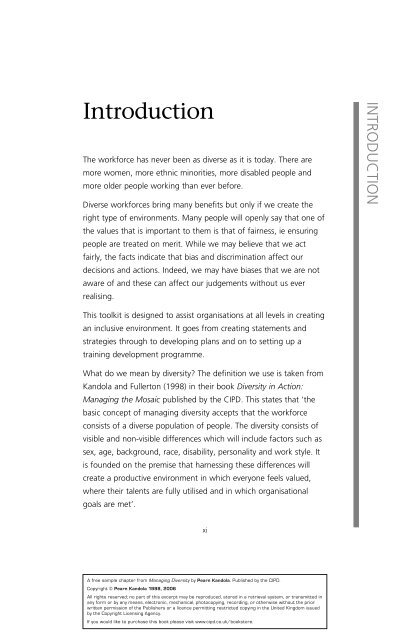CD13114 pr(s).qxp - Chartered Institute of Personnel and ...
CD13114 pr(s).qxp - Chartered Institute of Personnel and ...
CD13114 pr(s).qxp - Chartered Institute of Personnel and ...
Create successful ePaper yourself
Turn your PDF publications into a flip-book with our unique Google optimized e-Paper software.
Introduction<br />
The workforce has never been as diverse as it is today. There are<br />
more women, more ethnic minorities, more disabled people <strong>and</strong><br />
more older people working than ever before.<br />
Diverse workforces bring many benefits but only if we create the<br />
right type <strong>of</strong> environments. Many people will openly say that one <strong>of</strong><br />
the values that is important to them is that <strong>of</strong> fairness, ie ensuring<br />
people are treated on merit. While we may believe that we act<br />
fairly, the facts indicate that bias <strong>and</strong> discrimination affect our<br />
decisions <strong>and</strong> actions. Indeed, we may have biases that we are not<br />
aware <strong>of</strong> <strong>and</strong> these can affect our judgements without us ever<br />
realising.<br />
This toolkit is designed to assist organisations at all levels in creating<br />
an inclusive environment. It goes from creating statements <strong>and</strong><br />
strategies through to developing plans <strong>and</strong> on to setting up a<br />
training development <strong>pr</strong>ogramme.<br />
What do we mean by diversity? The definition we use is taken from<br />
K<strong>and</strong>ola <strong>and</strong> Fullerton (1998) in their book Diversity in Action:<br />
Managing the Mosaic published by the CIPD. This states that ‘the<br />
basic concept <strong>of</strong> managing diversity accepts that the workforce<br />
consists <strong>of</strong> a diverse population <strong>of</strong> people. The diversity consists <strong>of</strong><br />
visible <strong>and</strong> non-visible differences which will include factors such as<br />
sex, age, background, race, disability, personality <strong>and</strong> work style. It<br />
is founded on the <strong>pr</strong>emise that harnessing these differences will<br />
create a <strong>pr</strong>oductive environment in which everyone feels valued,<br />
where their talents are fully utilised <strong>and</strong> in which organisational<br />
goals are met’.<br />
xi<br />
A free sample chapter from Managing Diversity by Pearn K<strong>and</strong>ola. Published by the CIPD.<br />
Copyright © Pearn K<strong>and</strong>ola 1998, 2006<br />
All rights reserved; no part <strong>of</strong> this excerpt may be re<strong>pr</strong>oduced, stored in a retrieval system, or transmitted in<br />
any form or by any means, electronic, mechanical, photocopying, recording, or otherwise without the <strong>pr</strong>ior<br />
written permission <strong>of</strong> the Publishers or a licence permitting restricted copying in the United Kingdom issued<br />
by the Copyright Licensing Agency.<br />
If you would like to purchase this book please visit www.cipd.co.uk/bookstore.<br />
INTRODUCTION

















